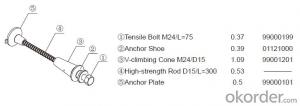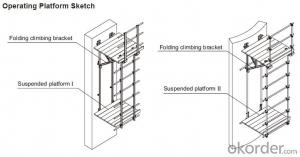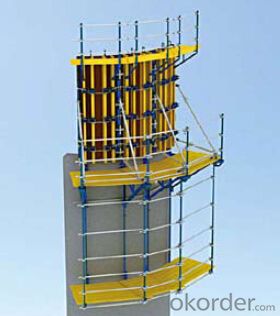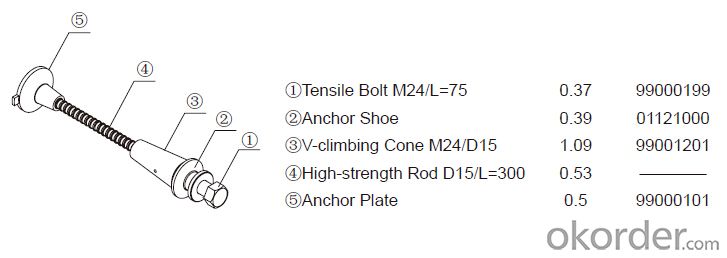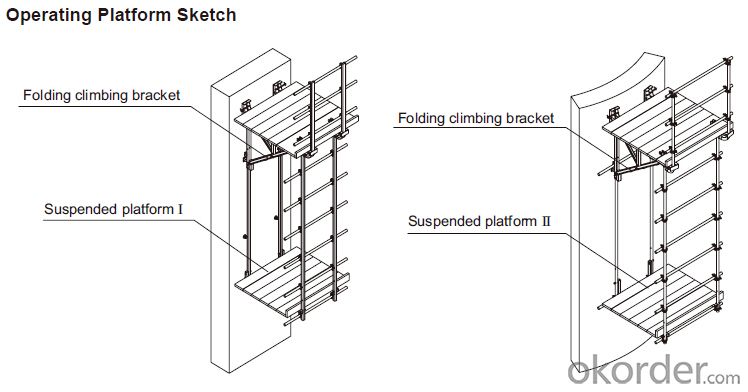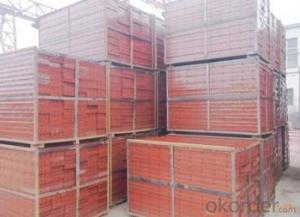Climbing Platform CP 190 for Formwork and Scaffolding systems
- Loading Port:
- Tianjin
- Payment Terms:
- TT OR LC
- Min Order Qty:
- 50 m²
- Supply Capability:
- 1000 m²/month
OKorder Service Pledge
OKorder Financial Service
You Might Also Like
Climbing Platform CP190
Climbing bracket CP190 is mainly used as operating platform during construction. It can be used
on the vertical wall and arced wall. The bracket hang on the anchor system and all the load are
supported by anchor system. It’s convenient to assemble and dismantle, the construction is easy,
rapid and safe.
Anchor System:
Anchor system is the most important supporting part. The system is made of five parts shown
below. There into, tensile bolt, anchor shoe and V-climbing cone can be taken out for reusing.
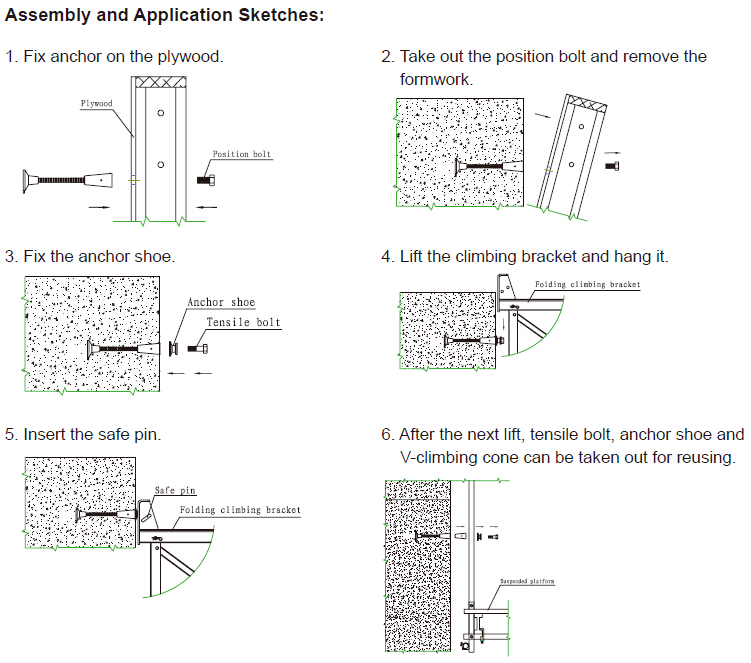
- Q: How are steel formwork systems assembled and disassembled?
- Steel formwork systems are assembled by first laying out the required panels and connecting them with pins or bolts. The panels are then aligned and secured using adjustable clamps or wedges. Once the formwork is assembled, reinforcement bars are placed, followed by pouring of concrete. Disassembling the steel formwork involves removing the formwork panels, undoing the clamps or wedges, and carefully dismantling the system in a systematic manner to ensure the safe removal of all components.
- Q: What are the different types of supports used in steel formwork installation?
- There are several types of supports used in steel formwork installation, including adjustable steel props, timber props, soldier beams, and trusses. These supports are used to provide stability to the formwork system and ensure proper alignment and load distribution during the construction process.
- Q: What are the different components of a steel formwork system?
- A steel formwork system typically consists of several components that work together to create a sturdy and reliable structure for concrete casting. These components include: 1. Panels: Steel formwork panels are the main part of the system and are usually made of high-quality steel sheets. These panels are designed to provide a smooth and even surface for concrete pouring. They come in different sizes and shapes to accommodate various types of construction projects. 2. Connectors: Connectors are used to join the panels together and ensure they remain in place during concrete pouring. These connectors can be in the form of clamps, bolts, or pins, and they help to create a tight and secure fit between the panels. 3. Props: Props or vertical supports are used to provide additional support and stability to the formwork system. They are designed to withstand the weight of the concrete and prevent the formwork from collapsing. Props can be adjustable in height, allowing for flexibility in formwork design. 4. Beams: Steel beams are used to support the weight of the formwork system and transfer it to the ground. These beams are typically placed horizontally and provide a strong framework for the panels and other components to rest on. They are often adjustable in length to accommodate different project requirements. 5. Bracing: Bracing elements, such as diagonal struts and cross braces, are used to reinforce the formwork system and prevent it from buckling or deforming under the pressure of the concrete. These bracing components are strategically placed to distribute the load evenly and enhance the overall stability of the system. 6. Accessories: There are various accessories that can be used to enhance the functionality and efficiency of a steel formwork system. These include corner pieces, wedge bolts, release agents, and chamfer strips. These accessories help to improve the overall performance of the formwork system and ensure smooth and accurate concrete casting. Overall, a steel formwork system is a comprehensive solution for creating strong and durable concrete structures. Its different components work together to provide stability, flexibility, and ease of use, making it a preferred choice in various construction projects.
- Q: What type of concrete finishes can be achieved with steel formwork?
- Steel formwork offers a multitude of possibilities for achieving various concrete finishes. A popular choice is a smooth and level surface, which can be accomplished by using steel formwork with a sleek texture. This finish is well-suited for areas that necessitate an even and flat surface, such as floors and walls. Another option is to achieve a textured or patterned surface using steel formwork. This can be done by utilizing formwork with a textured or patterned surface itself, or by incorporating additional materials like rubber or plastic liners to create the desired texture or pattern. This finish is often employed for decorative purposes, such as architectural concrete elements or exposed aggregate finishes. Furthermore, steel formwork allows for the creation of curved or shaped concrete surfaces. This involves bending or shaping the formwork prior to pouring the concrete, resulting in unique and visually pleasing shapes. This type of finish is commonly used in architectural or artistic applications. Ultimately, steel formwork provides a versatile solution for achieving a diverse range of concrete finishes, including smooth, textured, patterned, and curved surfaces. The choice of finish depends on the specific requirements and desired aesthetics of the project.
- Q: How does steel formwork contribute to improved construction site access?
- Steel formwork contributes to improved construction site access in several ways. Firstly, steel formwork is highly durable and reliable, which allows for the creation of robust and stable structures. This means that construction sites can be accessed more easily and safely by workers, as they can confidently navigate the formwork without concerns about its stability or integrity. Secondly, steel formwork is highly versatile and can be customized to fit any project's specific requirements. This flexibility allows for the creation of complex shapes and designs, which can improve access to different areas of the construction site. For example, curved or inclined formwork can be used to create ramps, staircases, or other access points that facilitate movement and navigation around the site. Additionally, steel formwork is known for its high load-bearing capacity, which means that it can support heavy loads and equipment. This is particularly important in construction projects that involve the use of cranes, scaffolding, or other heavy machinery. By providing a sturdy platform, steel formwork ensures that access is maintained even when heavy loads need to be transported across the site. Furthermore, steel formwork is quick and easy to assemble, which can significantly reduce construction time and improve access on site. Its modular design allows for efficient installation and dismantling, meaning that access points can be created or modified as needed in a timely manner. This is particularly beneficial in projects where construction schedules are tight or where the site layout needs to be adapted frequently. In summary, steel formwork contributes to improved construction site access by providing durability and stability, allowing for versatile designs, supporting heavy loads, and enabling quick and easy assembly. These features enhance worker safety, facilitate movement around the site, and help maintain productivity and efficiency in the construction process.
- Q: What are the different cost considerations associated with steel formwork?
- Some of the cost considerations associated with steel formwork include the initial purchase or rental cost of the formwork system, transportation and handling costs, installation and dismantling costs, maintenance and repair costs, and the potential for reusability and long-term cost savings compared to other formwork materials.
- Q: How does steel formwork contribute to the overall thermal insulation of the building?
- The use of steel formwork in construction does not directly impact the building's thermal insulation. However, it plays a vital role in shaping the concrete walls, floors, and ceilings, which indirectly affects the building's thermal insulation. During construction, steel formwork acts as a temporary mold or framework for pouring concrete. It provides necessary support and holds the concrete in place until it solidifies and gains strength. On the other hand, the concrete itself acts as a thermal mass, absorbing, storing, and releasing heat energy. The primary factors that determine a building's thermal insulation are materials like insulation boards, windows, doors, and the overall design of the building envelope. These components work together to reduce heat transfer and maintain a comfortable indoor temperature. Nevertheless, if the steel formwork lacks proper insulation or if there are gaps between the formwork and the insulation, thermal bridges can occur. These bridges allow heat to easily transfer between the interior and exterior of the building, leading to energy loss and diminished thermal performance. To address this issue, it is crucial to ensure that the steel formwork is adequately insulated and any gaps or joints are properly sealed. This can be achieved by incorporating insulation materials, such as rigid foam boards or spray foam insulation, between the formwork and the concrete. In conclusion, while steel formwork itself does not contribute to a building's thermal insulation, its correct installation and appropriate insulation around it can help prevent thermal bridges and enhance the overall thermal performance of the structure.
- Q: How does steel formwork affect the overall timeline of a construction project?
- Steel formwork can have a significant impact on the overall timeline of a construction project. One of the major advantages of using steel formwork is its durability and reusability. Unlike traditional timber formwork, steel formwork can be used multiple times, which reduces the time spent on constructing and dismantling formwork for each concrete pour. The strength and rigidity of steel formwork also allow for faster construction cycles. Since steel formwork can withstand higher concrete pressure, it enables faster pouring and setting of concrete, leading to shorter curing times. This, in turn, allows subsequent construction activities to commence earlier, ultimately accelerating the overall project timeline. Moreover, steel formwork is known for its precision and dimensional stability. It provides a smooth and accurate surface finish, eliminating the need for additional plastering or leveling work. This saves time and reduces the number of construction activities required, further enhancing the project timeline. Additionally, steel formwork is typically prefabricated, meaning it is manufactured off-site and delivered to the construction site ready for assembly. This significantly reduces on-site construction time, as the formwork can be quickly erected and adjusted to the desired shape and dimensions. This timely installation ensures that other trades can progress with their work without delays, ultimately speeding up the overall construction process. However, it is important to note that the initial setup time for steel formwork can be longer compared to other types of formwork, as it requires careful planning and coordination. The formwork design must be accurately calculated, and any modifications or adjustments may take additional time. Nevertheless, the time saved during subsequent concrete pours and other construction activities usually compensates for this initial setup period. In conclusion, steel formwork positively impacts the overall timeline of a construction project by reducing the time spent on constructing and dismantling formwork, enabling faster concrete pouring and curing, providing a precise and finished surface, and facilitating quick and efficient on-site assembly. Its durability and reusability contribute to a more efficient and timely construction process, resulting in a shorter overall project duration.
- Q: How is steel formwork cleaned and maintained?
- Steel formwork is commonly used in construction projects due to its durability and reusability. To ensure its longevity and to maintain its quality, regular cleaning and maintenance are crucial. Here are some steps to clean and maintain steel formwork: 1. Remove concrete residue: After each use, any concrete residue should be removed from the steel formwork. This can be done by chipping away the hardened concrete using a hammer or chisel. Care should be taken not to damage the formwork surface during this process. 2. Power washing: Once the larger chunks of concrete are removed, power washing can be done using a high-pressure water jet. This helps to dislodge any remaining concrete particles and dirt from the surface of the formwork. Make sure to use appropriate safety measures, such as wearing protective clothing and goggles, while power washing. 3. Chemical cleaning: In cases where stubborn stains or concrete deposits are difficult to remove through power washing alone, a chemical cleaning solution can be used. There are various commercially available concrete removers that can be applied to the formwork surface. Follow the manufacturer's instructions for proper usage and safety precautions. 4. Rust removal and prevention: Steel formwork is susceptible to rusting, which can weaken its structural integrity. Regularly inspect the formwork for any signs of rust and remove it using wire brushes or sandpaper. After rust removal, apply a rust-inhibiting primer or a protective coating to prevent further rusting. This should be done before storing the formwork to ensure it remains in good condition. 5. Proper storage: When not in use, steel formwork should be stored in a clean and dry environment. Avoid exposure to moisture, extreme temperatures, and corrosive substances, as these can adversely affect the formwork's quality. Proper stacking and organization can also prevent damage and deformation during storage. Regular maintenance and cleaning of steel formwork is essential to ensure its longevity and reusability. By following these steps and taking appropriate precautions during cleaning and storage, steel formwork can be kept in optimal condition for future construction projects.
- Q: What are the common safety guidelines when working with steel formwork?
- When working with steel formwork, there are several common safety guidelines that should be followed to ensure the well-being of workers and prevent accidents. These guidelines include: 1. Personal Protective Equipment (PPE): All workers should wear appropriate PPE, including safety helmets, safety glasses, gloves, and steel-toed boots. This will protect them from falling objects, cuts, and other potential hazards. 2. Training and Competency: Workers should receive proper training on how to use and handle steel formwork. They should be knowledgeable about the specific tasks they are assigned and have the necessary skills to perform them safely. 3. Inspections: Regular inspections of the steel formwork should be conducted before and during use to ensure that it is in good condition and free from defects. Any damaged or faulty parts should be repaired or replaced immediately. 4. Proper Handling: Steel formwork can be heavy and cumbersome, so it is essential to use proper lifting techniques and mechanical aids when moving or positioning it. Avoiding excessive strain and overexertion can help prevent musculoskeletal injuries. 5. Secure Installation: The formwork should be securely installed and braced to prevent collapse or displacement during concrete pouring. It should be properly aligned and supported to ensure stability throughout the construction process. 6. Fall Protection: Adequate fall protection measures, such as guardrails or safety harnesses, should be in place when working at heights. Additionally, workers should be cautious of slippery surfaces and take necessary precautions to prevent slips, trips, and falls. 7. Hazard Communication: Clear signage and warnings should be posted to alert workers to potential hazards and provide instructions on safety procedures. Communication among workers and proper coordination is also crucial to prevent accidents. 8. Regular Maintenance: Routine maintenance and cleaning of the steel formwork should be performed to remove debris, rust, or other materials that could compromise its integrity. This will help ensure its safety and longevity. By following these common safety guidelines when working with steel formwork, the risk of accidents and injuries can be significantly reduced, creating a safer work environment for all involved.
Send your message to us
Climbing Platform CP 190 for Formwork and Scaffolding systems
- Loading Port:
- Tianjin
- Payment Terms:
- TT OR LC
- Min Order Qty:
- 50 m²
- Supply Capability:
- 1000 m²/month
OKorder Service Pledge
OKorder Financial Service
Similar products
Hot products
Hot Searches
Related keywords

